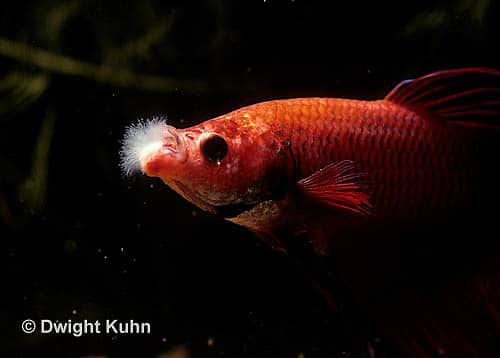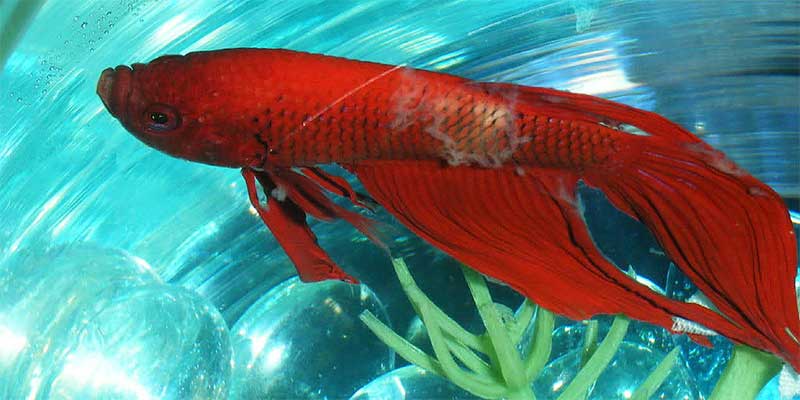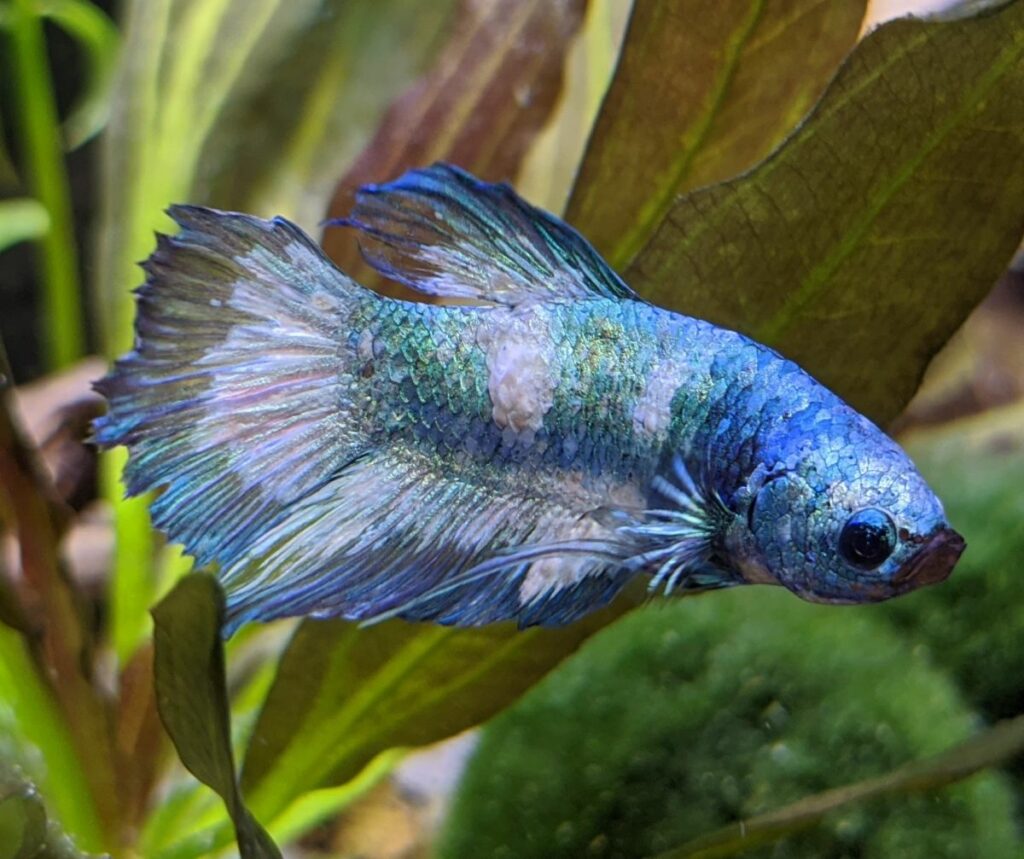Cotton wool disease is a sickness in aquarium fish that can arise unexpectedly. It is fatal if left untreated and it can be complicated to deal with because it looks a lot like fungi and other aquarium fish diseases.

The symptoms of the disease are also varied somewhat, making the diagnosis even more challenging. Fortunately, we are here to help to figure out what cotton wool disease looks like, its causes, and how to treat columnaris disease in fish.
What is Cotton Wool Disease in Fish?
Cotton wool disease in fish is caused by a bacterium that goes by the Latin name Flavobacterium columnare. Also known simply as columnaris bacteria, these germs can actually be found in any aquarium, no matter how healthy or clean.
Columnaris bacteria can be found on the skin, mucus membranes, gills, and even inside healthy fish. In small, controlled numbers, they are harmless organisms. However, they have the tendency to explode in population if the conditions are just right. When this happens the columnaris bacteria become cotton wool disease, transforming into a dangerous and contagious infection.
What Causes Cotton Wool Disease in Fish?
Columnaris bacteria are always present in an aquarium environment. Normally they don’t cause any problems at all – so how is it they can cause a debilitating and deadly disease?
Cotton wool disease almost always arises when fish are kept in polluted and crowded conditions. Overcrowding fish leads to high levels of nitrate and ammonia, both of which create stress on the immune system. Many fish tanks kept in these conditions are equipped with filters that are too weak to properly process biological waste products.
Also, the high levels of feces, fish food, and other organic debris also creates a rich food source for bacteria and other germs to multiply. All of this places stress on the biology and anatomy of your fish. Until the columnaris bacteria have the chance to gain a permanent hold on the body of a weak fish.
The bacteria then multiply, forming thick patches of growth and discolored or dead patches of skin. As they spread, they take on the appearance of a small cotton ball or a sheep’s wool, hence the name “cotton wool disease.”
Columnaris is actually very common not only in overcrowded aquarium fish tanks but also in the food fish industry. According to Wikipedia, it is the second leading cause of death in the catfish farming industry of the Southeastern United States. Since catfish are scaleless fish, they are even more sensitive to skin infections like cotton wool disease.
Betta Fish Cotton Wool Disease

Unfortunately it is very common to see betta cotton wool disease in pet stores and home aquariums. Since betta fish are very hardy and tolerate high pollution levels, people sometimes decide that their betta does not need a filter. However, this is not the case; betta fish definitely need a filter to remove waste products and prevent bacteria levels from becoming dangerously high.
When kept in dirty water, betta fish frequently get columnaris, fin rot, and other opportunistic diseases. Fortunately, columnaris betta treatment is straightforward and it can be prevented forever with the right steps taken.
Symptoms of Cotton Wool Disease
The illness is one of the easier aquarium fish diseases to identify. Sometimes you may confuse cotton wool disease with fungal infections but there are ways to tell the two apart.
The main symptoms of cotton wool disease in fish are:
- Slimy, cotton-like patches or growths
- Discolored skin below the cottony growth; typical white, gray, or black
- Excess slime coat production
- Loss of appetite
- Swimming near the surface or hanging along the bottom of the tank
- The entire region of the fish (fins, skin, etc) deteriorating, possibly causing swimming problems and death
Something to remember is that the cotton growths of columnaris bacteria can show up anywhere on your fish. And when that happens the disease sometimes gets different names. “Mouth rot” or “cotton mouth” is really just columnaris that takes hold around the mouth and gill tissues. It can also grow around one or both eyes, where it gets a different name sometimes.
Columnaris vs Fungus Disease
Fin and body fungus are very similar in cause and appearance to cichlid cotton wool disease. Both show up as wooly patches of growth on the skin, fins, and other parts of the body that grow thicker over time. So how can we tell the difference between columnaris versus a fungal infection?
Well, the only way to be absolutely sure is to look under a microscope. Columnaris is a bacterial infection while fungal infections show up as stringy hyphae that look like long threads. Once the disease progresses it can be a lot more difficult to tell the two apart.
However in the beginning cotton wool disease looks like a slimy patch of mucus that eventually grows out into a cotton like growth. Skin and fin fungus, on the other hand, will always look cottony from the beginning.
Columnaris also can be a light yellow, gray, or brown color (but also white at times). Skin, fin, and body fungus tend to be white in color all of the time.
Columnaris vs Ich Disease
Ich is another aquarium fish disease that is common to see in crowded fish tanks. However it is a lot easier to tell the difference between cotton wool and ich.
Ich shows up as small white spots about the size and color of salt. In a heavy infection a fish might look like someone took a salt shaker and sprinkled some all across its body. However a fish may only have one or a few of these “salt spots” at first.
Meanwhile columnaris disease in fish shows up as cottony patches of growth that are usually only in one spot. The spot can grow larger as the disease worsens, though.
Both cotton wool disease and aquarium ich are very infectious to the other fish in the tank. But ich is a lot less dangerous to fish and easier to cure.
Can Cotton Wool Disease Kill Fish?
If left untreated and the conditions remain dirty and polluted cotton wool disease can kill fish. In fact, it can even leave them permanently crippled if the disease attacks a fin. The entire fin can rot away, including the basal cells, which prevents the fins from being regrown once the disease is cured.
Once this happens your beloved pet fish may have a permanent “limp,” a damaged fin, or missing fins. These sorts of injuries can also be permanent if columnaris overgrows along one of the eyes, lips, mouth, or gills of your fish.
Treatment for Cotton Wool Disease in Fish

Columnaris treatment is difficult but not impossible. The key is to catch the infection early and use the right medications for the job. Let’s talk about how to treat cotton wool disease in fish.
Cotton Wool Disease Salt Treatment
One of the most effective ways to treat columnaris fish disease is to use aquarium salt in a salt bath. The bacteria behind the disease are freshwater only and have a very low tolerance to salt. However our fish are also freshwater so we don’t want to overdo it with too much salt.
You can create a salt bath using a concentration of a tablespoon of aquarium salt dissolved in a gallon of tank water. Allow your fish to bathe in the solution for up to 5 minutes and then return it to the fish tank.
Alternatively, you can add one tablespoon of aquarium salt per five gallons to the tank. While this is not as effective the salt still causes the columnaris disease some stress. If your fish are tolerant of brackish water, such as mollies, then increasing the salt levels even higher can eliminate cotton wool disease in fish entirely.
Using Medication on Columnaris
The key to any cotton wool disease cure is to catch the infection as soon as possible. Assuming the growth is not too aggressive it does respond well to medication as well as clean living conditions.
I recommend using API Melafix when dealing with cotton wool disease in fish treatment. The active ingredients are tea tree oil, which is naturally antimicrobial.
Does Furan-2 Treat Columnaris?
Furan-2 is one of the best remedies for columnaris treatment. As an antibiotic, Furan-2 targets the bacteria that cause not only cotton wool disease but also red spots and sores (Aeromonas sp.).
Regardless of which treatment you choose, I always recommend moving your fish to a quarantine aquarium. This way, you can add medications without disrupting your beneficial nitrifying bacteria that make up your biological filtration system.
Also you can raise the temperature, add salt, and help a slow eater get enough food and not have to compete with the other fish in the tank.
More Frequently Asked Questions about Columnaris
Columnaris disease symptoms include cottony growths of bacteria that can be white, yellow, gray, or brown in color. Excess mucus can occur in the skin of your fish and they may lose their appetite and willingness to swim. The skin around the cotton wool growth may also become discolored.
Columnaris looks a lot like a fungal infection. However it is actually caused by Flavobacterium columnare, a common freshwater bacteria that can be found in any fish tank. However if the germs become infectious they lead to cotton wool disease in fish.
Since the bacteria live only in aquatic freshwater environments, columnaris is unlikely to be able to infect humans. Even so, always wash your hands after working in and around your aquarium.
The longer columnaris cotton wool disease goes, the harder it is to cure. And even if it is cured, infected fins and skin can be permanently damaged from the disease. So the faster you recognize it and follow the steps in this guide the greater your chances of success will be.

